The truth? Five INCONVENIENT truths about EVs
We’re big EV advocates at Leasing.com. Year-on-year we’re seeing a big swing towards customers choosing electric power. The benefits are obvious. We’ve even debunked some myths that people believe about battery electric vehicles.
But we’re nothing if not balanced. We understand that even in 2023, an EV won’t be for everyone. The reasons to NOT choose an electric vehicle are ever decreasing, but some stubborn points remain.

We’ve taken a deep-dive into five inconvenient truths that still ring true. Will they be resolved anytime soon? We’re by no means trying to slag EVs off here, simply highlighting some trade-offs you make if you choose electric power. Let’s jump into it.
Some potentially inconvenient truths about EVs are:
- The fact they aren’t completely CO2-free;
- Battery production isn’t sustainable in its current form;
- There’s a difference between official range and real-world range;
- Charging networks are still in the works;
- They weigh more than other vehicles.

1. They aren’t completely CO2-free
Electric cars are good for the environment, right? That’s what we’ve been told by governments, manufacturers and marketing companies. On the face of it, they are. But a closer look reveals that things are much more complicated. It’s important to remember that driving an EV isn’t a 100% solution when it comes to emissions.
Traditional petrol and diesel cars have long been accused of being a major contributor of CO2 emissions. Eliminate as many of these “tailpipe” emissions as you can, and many think we’ll get an instantaneous reduction of CO2 and other harmful emissions.
The truth is a bit more complicated. This is because EVs create more emissions to manufacturer than their petrol counterparts. The amount of energy used to create batteries and other EV tech can produce around 80% more emissions than building a comparable petrol car.
It’s important to remember that driving an EV isn’t a 100% solution when it comes to emissions.
There are many and varied findings on this topic, because as well as the energy used to produce an EV, you also need to factor in what energy is used to charge them.
For example, in a country like Norway that uses predominantly Hydro-power to supply electricity, the carbon footprint of EVs after they are produced will be virtually zero.
But if you live in a country that still depends on coal and oil, this will of course be a different story. Decarbonising the world’s electric grids will be just as important as uptake of EVs themselves as far as reducing harmful emissions go.
That said, over the lifetime the entire lifetime of a vehicle, EVs still fare better overall.

2. Battery production isn’t as sustainable as it needs to be
EV production needs batteries. Known as lithium-ion batteries, these power packs are improving all the time. But when we said that EVs create 80% more emission than a comparable petrol car during production? Most of that is from the extraction and refinement of battery materials.
The use of minerals such as lithium, cobalt and nickel are all required to create the modern long-range batteries most EVs use today. The intensive sourcing and manufacturing processes of batteries are often toxic, not just to the environment, but to humans too.
It's not 100% certain whether battery supplies will remain sustainable
It’s hard to make like-for-like comparisons, but these environmental hazards aren’t dissimilar to those created by the mining and refining of oil. It’s also a fact that many of these mines are found in China, which dominates the global supply chain.
Long-term, it’s not sure whether this battery supply will be sustainable. Many countries are scrambling to find other sources of these materials in order to cut reliance on imports from Chinese mining companies.

3. There’s still a difference between real-world range and official range
Official figures are one thing, but in the real world EV range can be a little disappointing. A report by Car and Driver found that at 75mph, 350 internal combustion engined vehicles average 4% better fuel economy than was their official figure. EVs, on the other hand, performed 12.5% worse than official stats.
It’s true that the range EVs offer has been increasing quickly, with many on the market now offering more than 300 miles between charges. But some drivers have found that in certain conditions, it’s difficult to eek out the maximum stated range from the vehicle.
In certain conditions, it’s difficult to eek out the maximum stated range from the vehicle.
In turn, this reinforces people’s range anxiety – something that for most people who travel an average amount of miles don’t need to worry about in the first place. As far as manufacturers go, Tesla, Mercedes and BMW have been found to offer the closest to their official range.
If you want to find out which EVs have the best official ranges, you can read our EVs ranked by electric range to find out.

4. Charging networks are still in their (relative) infancy
The UK’s electric vehicle charging infrastructure has expanded five-fold in recent years. But the industry still has a long way to go if it wants everyone to drive a fully electric vehicle. The charging network has several challenges that ideally need to be overcome.
Chief of these is the inter-operability (or lack of) between some charging networks. The number of communication and agreements between grid, utility companies and charging manufacturers are still low on the ground.
One day public charging will be as simple as pouring petrol into your tank, but we’re not quite there yet.
This limits the possibility of a truly inter-operable system that’s as simple to operate as a petrol pump. We’re sure this will come in time, but if you’re thinking about an EV right now, we’d advise you to get ahead of the game – research and join charging networks so you’re ahead of the game.
There’s tonnes of different apps and payment methods. Ionity, BP Pulse, Fastned, GeniePoint, Pod Point, Shell recharge. These are just a few of the networks currently operating in the UK.
One day public charging will be as simple as pouring petrol into your tank, but we’re not quite there yet.

5. They’re heavier than petrol and diesel models
One thing that isn’t mentioned often is the fact that electric vehicles are actually much heavier than cars powered by combustion engines. This is due to the battery packs.
While moving them as low down as possible in the car ensures the driver doesn’t really notice this extra weight, it is apparently having an effect on our roads.
A recent report highlighted the fact that pothole damage from EVs is double that of petrol vehicles. The Telegraph found the average electric car puts at least two times more stress on roads than petrol equivalents.
A recent report highlighted the fact that pothole damage from EVs is double that of petrol vehicles.
With the country already suffering from a “pothole crisis”, more EVs on the road certainly won’t help. Another concern is for ageing multi-storey car parks. All this extra weight will put a strain on some older buildings, which were designed to accommodate much lighter and smaller vehicles.
A structural engineer even highlighted the potential for some really old car parks in poor condition to collapse. This is an overlooked area that will no doubt need further consideration as EV uptake continues to grow.
But let’s talk about the benefits
Despite our five sticking points above, on the whole, the move towards electric drivetrains is a positive one. Technology is only set to improve further over the coming years and, old car parks aside, there’s no getting around the fact that by 2030 almost 100% of new cars available will be electric powered.
We’ve got loads of helpful content if you’re considering an EV as your next car. You can check out some dos and don’ts when it comes to charging, or perhaps take another look at our myth-busting article. If you’ve no idea where to start, you may want to take a look at our A to Z of electric vehicles.
